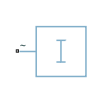Constant Current Load (Three-Phase)
Libraries:
Simscape /
Electrical /
Passive
Description
The Constant Current Load (Three-Phase) block implements a constant current load for a three-phase supply.
This block consumes a current equal to the value of the Consumed current (RMS) parameter as long as the voltage from the three-phase supply is equal to or greater than the value specified for the Minimum supply voltage (phase-to-phase RMS) parameter.
When the voltage from the three-phase supply drops below the value of Minimum supply voltage (phase-to-phase RMS), the load behaviour changes and the block models a load with constant resistance.
Equations
If the three-phase voltages are balanced, the phase-to-phase RMS voltage is defined by this equation:
where
The currents for each of the three phases are defined by this equation:
where Requiv is the equivalent resistance and depends on value of the Minimum supply voltage (phase-to-phase RMS) parameter.
If the voltage from the three-phase supply is greater than the value specified for the Minimum supply voltage (phase-to-phase RMS) parameter, the equivalent resistance is defined by:
where vpk is the voltage peak magnitude and IRMSconsumed is the value of the Consumed current (RMS) parameter.
If the voltage from the three-phase supply is less than the value specified for the Minimum supply voltage (phase-to-phase RMS) parameter, the equivalent resistance is defined by:
where is the phase-to-ground RMS minimum voltage.
Faults
To model a fault in the Constant Current Load (Three-Phase) block, in the Faults section, click Add fault next to the fault that you want to model. For more information about fault modeling, see Fault Behavior Modeling and Fault Triggering.
The Constant Current Load (Three-Phase) block allows you to model an electrical fault as an open circuit. The block can trigger fault events either:
At a specific time
When a power limit is exceeded for longer than a specific time interval
Load-Flow Analysis
If the block is in a network that is compatible with frequency-time simulation mode, you can perform a load-flow analysis on the network. A load-flow analysis provides steady-state values that you can use to initialize a machine.
For more information, see Perform a Load-Flow Analysis Using Simscape Electrical and Frequency and Time Simulation Mode.
Ports
Conserving
Parameters
Extended Capabilities
Version History
Introduced in R2021a
